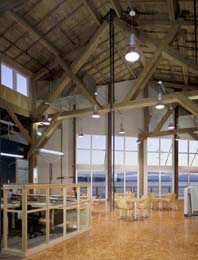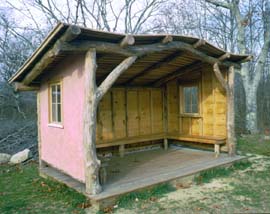Builder John Abrams of Martha’s Vineyard tells one of his favorite stories:
- A woman approaches Gandhi to seek help with her son’s addiction to sweets. He listens to her concerns but does not meet with the child. Over the following weeks she asks him several more times for help. Each time he gently holds off. Finally, after many weeks and frequent requests, he meets with her son and miraculously solves his problem. The woman is very pleased but asks Gandhi why he took so long to work with her son. Gandhi calmly replies, “I had to solve my own sugar habit before I could approach your son.”
Abrams is convinced that to create truly green buildings and run a socially responsible business, a company has to “walk the talk.” When he speaks to groups, rather than telling others how they should run their businesses, he humbly describes his own business, South Mountain Company. He describes his experiences in guiding it – not only to design and build environmentally responsible houses – but also in how the business is run.
This article looks at how design and construction companies can incorporate environmental and social responsibility into operations. Every company can look at how it operates internally to practice sustainability. By implementing our own green business practices, we learn a tremendous amount, we gain credibility in the eyes of our clients, we realize the environmental and health benefits we try to create for others, and we play our own important part in the shift toward sustainability.
We will profile several design and construction companies to see what they are doing to green their operations. A checklist of green business strategies is at the end of the article.
McStain Enterprises – Production Home Builder/Developer, Boulder, CO.
This Metro Denver home won the 1998 Parade Built Green Home of the Year award. McStain fought to keep its size 2000 sf smaller (deemed “unmarketable”) than six neighboring homes; it was one of the first homes to sell. |
McStain builds over 250 homes a year and employs 125 people – ranging from designers and carpenters to a sales force. In business for over 34 years, McStain is regarded as one of the leading green builders in Colorado, if not the country. The company participates in the DOE Building America program and received the coveted Colorado Ethics in Business Award (the first home builder ever to receive this honor) this year. McStain exceeds the standards of even the Metro Denver Home Builders’ Built GreenSM program. But the “greenness” of McStain Enterprises is not limited to the developments they create and the homes they build. “Green is part of everything we do,” says Tom Hoyt, owner.
Their “Green Team” is a 10- person volunteer group of employees representing all departments. It ensures that green business practices get implemented across the company and ideas that really work rise to the top. The McStain corporate giving program works in three ways: they give a grant to a local nonprofit organization working on sustainability; they support local environmental events or actions through a revolving fund; and they match employees’ charitable contributions. Grants are based on a percentage of profit and last year totaled about $40,000.
In a striking example of green business and big picture thinking, McStain is integrating a nonprofit environmental education and resource center into their next big development project. They are building a mixed-use residential/commercial/office park project – in nearby Loveland -on 3,000 acres (1,200 ha) with extensive wetland and water resources. Knowing that the center director should oversee the development of the center and the overall project they hired the director a year before starting the project.
“Our customers and employees are hungry for honesty, respect, and a genuine approach,” notes Hoyt. The company recently hired a highly skilled job-site super who waited nine months for a position to open up at McStain. “With customers and employees both seeking this type of experience, running a green business is just plain good business.”
Other green business features at McStain:
*
* P
* Office building energy audit: The Boulder Energy Conservation Center is conducting a
Mithun: Architecture Firm, Seattle, WA.
Mithun Architects + Designers + Planners is a full-service design
Mithun’s new office |
Bert Gregory, CEO, sees their new offices as a reflection of the company’s commitment to “walking the talk.” The company renovated an old pier facility that was chosen for a host of green and business reasons, incorporating daylighting, passive ventilation/cooling, high-quality fluorescent task lighting, and few finishes to ensure healthy indoor air quality. The renovation has sparked interest (and potential revenue) from a neig
hboring business wanting to reincarnate its own building. Chris Dixon, recently hired as director of specifications, joined the firm because of its commitment to sustainability. And Dixon has attracted two new employees to Mithun for the same reasons. Some of their other green operational features are:
* Selected janitorial services based on commitment to environmental protection and use of nontoxic cleaning agents. Mithun is evaluating a variety of office supplies using the EPA Environmentally Preferable Purchasing Program Pilot Study.
* Green products – 100% recycled-content, chlorine-free paper is used office-wide. There is no longer any use of blueprints or blueline, and all large prints are recycled.
South Mountain Company: residential design-build, Martha’s Vineyard, MA.
South Mountain Company built and donated this mass transit shelter made from salvaged/certified materials
|
For 25 years, South Mountain Company has been a leading custom homebuilder on Martha’s Vineyard. Founded by John Abrams, the $5 million (annual) company employs 25 people and primarily builds single-family homes. Abrams attributes much of his company’s emphasis on sustainability to their island surroundings. “Living and building on a beautiful but environmentally stressed island makes thinking about the impact of our business imperative,” he says. Recently, the owner-employees of South Mountain spent two company days engaged in a “Future Sketch”- a structured discussion and brainstorming charrette identifying what the company could do to foster sustainability on the island. They include: instituting a company policy to evaluate the impact of large homes (over 3500 square feet); increasing company charitable contributions from 5- 10% of profits (for local land conservation and to address the growing affordable housing crisis on the island); and broker used building materials locally. 90% of the exposed interior and exterior wood on the company’s projects, including their headquarters and shop is salvaged. With many houses being torn down to make way for new houses, salvage opportunities (and needs) are great. What else do they do?
* Bike facilities and carpooling incentive: Their building has outdoor showers, and the company subsidizes company carpooling efforts.
* Comprehensive purchasing and building operation policies: They scrutinize every aspect of business operations from an environmental perspective.
* Their 12-year old socially responsible pension fund is valued at about $1 million.
Greg Norris of Sylvatica, (North Berwick, ME) led a consulting team to assess the environmental impacts of the planned Montana State University EpiCenter. This building, being designed by BNIM Architects (Kansas City, MO) and the Center for Maximum Potential Building Systems (Austin, TX), will include many state-of-the-art environmental features. As part of the environmental impact analysis of the building, Sylvatica quantified the impacts of the design process for an average building of this type. The initial findings are dramatic: 4 – 5% of the environmental footprint of the building construction results from the activities of architecture and engineering firms. Sylvatica examined everything from producing paper for blueprints to transportation energy use and impacts of operating the design and engineering companies. In the Montana State project, the design firms’ environmental burden was roughly equal to that of the structural steel for the planned university building.
This inspired BNIM Architects to turn this analysis flashlight on itself. They looked for the priority levers for greening BNIM’s own day-to-day operations and reducing their footprint. The inputs of top importance include:
*
*
* Paper and printing;
* Business travel; and
* Office equipment.
Final Thoughts
All of us in the building community make a living off one of the most resource-intensive industries on the planet, an industry with enormous economic and environmental impact. The most important thing green design and construction firms can do relative to the environment is to continue creating low-environmental-impact buildings. Improved energy efficiency, reduced water use, less dependence on private automobiles for the people living or working in these buildings, greater use of green building materials, and healthier indoor environments are examples of how hundreds of leading-edge companies are practicing green design and construction. While pushing the envelope as far as possible in our design and construction services, however, we should also try to push that envelope even further with our own company operations and policies. Even the greenest of us have our “sugar habits” to work on.
Running a Green Business: A Checklist for Action
| IN-HOUSE MEASURES |
BUILDING DESIGN AND RENOVATION
Make your own facilities as green as possible. All company facilities should be energy-efficient and otherwise environmentally responsible. For example, large facilities can strive for a high score in the LEED Rating System.
Build demonstration facilities. Model homes, field offices, job-site trailers, and other facilities that have public visibility should serve to demonstrate your company values and technical know-how when it comes to green design. PV power on job-site trailers, for example, will give your company experience with this power source, while providing that important demonstration role with both the public and subcontractors.
TRANSPORTATION/TRAVEL
Encourage employee use of public transit. Provide passes, reimbursement, or other incentives for public transit use by employees.
Encourage carpooling or vanpooling. Provide incentives for employees to set up carpools or use company-organized vanpools. More convenient parking for carpools and providing free coffee and newspapers in vanpools are examples of incentives that could be provided.
Provide for bicycle and pedestrian commuting. Provide under-cover, secure storage for bicycles. Provide shower and changing facilities for employees wanting to bicycle, jog, or walk to work.
Pay employees not to drive. Consider allowing employees to opt for extra pay instead of a parking space “benefit” as a way to encourage alternatives to single-occupancy vehicle commuting.
Provide for telecommuting. Permit employees to work from home regularly or periodically. This not only reduces environmental impacts of commuting but also can improve efficiency and avoid time lost in traffic congestion. Provide home Internet connections and laptop computers to facilitate this.
Avoid some travel through teleconferencing. More and more options are becoming available for tele- or video-conferencing. These can save tremendous amounts of energy associated with air travel.
Allow flex time for traffic peak smoothing. By providing flexible work hours, time (and gasoline) wasted in traffic congestion can be reduced.
Provide higher mileage reimbursement for fuel-efficient cars. Encourage employees to purchase fuel-efficient vehicles by linking the reimbursement rate to the miles per gallon achieved by the employee’s vehicle.
Buy energy-efficient vehicles. If your company owns vehicles, be sure to include fuel economy as one of the selection criteria. Also consider alternative fuels and gasoline-electric hybrids.
Choose green hotels when on the road. When traveling, try to select hotels that adhere to strong environmental principles, or actively make your stay greener. If your hotel does not offer a specific option of not changing linens each night, for example, leave a note on the bed to that effect.
PURCHASING
Buy recycled paper. Select the highest-recycled-content paper that meets your requirements. When some virgin fiber is required for photographs or fine resolution, consider wood fiber content that is certified through Forest Stewardship Council (FSC) standards.
Buy energy-efficient office equipment. Choose Energy Star-rated office equipment and appliances, or go beyond Energy Star standards, choosing products with the highest efficiency ratings available. Compare EnergyGuide labels, energy factors, heating season performance factors, and other measures of energy performance.
Buy reusable dishes, utensils, and hand towels. Avoid disposable plastic and paper products whenever practical, and limit use of paper towels. Encourage employees to use their own mug for water, coffee, or tea.
Buy secondhand office furniture. Buying used furniture saves the energy and raw materials needed to manufacture new products. A number of companies market refurbished office furniture (see the EBN GreenSpec directory).
Buy natural or low-toxic cleaning and maintenance products. Help to maintain a healthy indoor environment by purchasing cleaning fluids, detergents, floor waxes, paints, and other products that offgas little, if any, VOCs, formaldehyde, and other potentially harmful compounds.
Buy “green power.” If available in your area, purchase green electricity (generated from renewable energy sources).
BUSINESS OPERATIONS
Recycle. Maintain an active and rigorous in-house recycling program for office paper, cardboard, beverage containers, toner cartridges, and any other products for which there are local recycling options. Extend recycling programs to the job site as well.
Promote “paperless operations.” Encourage company-wide use of e-mail; electronic invoicing and billing; “extranets” for communicating about projects among design team members; Web-based and electronic marketing; e-ticketing for travel; electronic transfer of building plans, etc.
Use responsible cleaning procedures and materials. Use low-impact cleaning practices or choose a green cleaning service to maintain a healthy indoor environment while minimizing environmental impacts.
Practice low-impact landscaping. Avoid chemical fertilizers and pest control; use water-efficient irrigation or practice xeriscaping; avoid two-cycle engine use when possible (lawn mowers, leaf blowers, edge trimmers, chain saws); use native plantings that will support diverse wildlife.
Maintain equipment. Follow rigorous maintenance schedules to maintain mechanical equipment in optimal working order and rated energy efficiency. This means regular replacement of filters, cleaning of compressor coils, burner tune-ups, lubrication of pumps and motors, proper vehicle maintenance, etc. Recycle waste oil and solvents, and use biodegradable lubricants and hydraulic fluids.
Avoid wasting energy after-hours. Instruct employees to shut down all office equipment at the end of the day or during prolonged periods of inactivity–and not to disable energy-saving features on personal computers and other Energy Star equipment. Make sure HVAC equipment is configured to set-back temperatures and ventilation rates after-hours. Programmable thermostats for smaller offices and more sophisti
cated energy management and control systems for larger buildings are recommended. Make all employees aware that screen-savers do not save energy.
Establish a company “green team.” For larger companies, establishment of a company-wide standing committee addressing greening initiatives is an excellent way to efficiently incorporate environmental planning into a company. (Green teams can also be used to help incorporate green measures into the company’s design and construction projects.)
ASSESSMENT OF IMPACTS AND PROGRESS
Calculate company “carbon balance.” Carry out careful accounting of environmental impacts of business operations. The easiest starting point is to assess carbon emissions from energy use in company buildings and vehicles, airline travel, paper use, and so forth.
Develop a plan to reduce carbon emissions. Set goals for reducing carbon emissions and track company progress in achieving those goals.
EDUCATION
Educate employees. Provide employees with in-house environmental education. Invite speakers to your office to address green design. When practical, set up opportunities for experts addressing company employees to also address the general public in your area.
| OFF SITE MEASURES |
Incorporate environmental issues into business planning. Improving corporate environmental sustainability should be a part of your mission statement and a component of strategic planning of the company. Environmental criteria, for example, could become a key factor in project selection.
Encourage employee participation in local environmental initiatives. Make it possible for employees to participate in local planning committees, to hold local office, or to volunteer time for Habitat for Humanity or a building materials exchange. Identify community activities for which employees can volunteer time during paid hours (say, two hours per week).
Play a proactive role in the community. Your company could be an agent of local environmental action. If there is a problem with sprawl in the area and your company has planning expertise, for example, consider sponsoring a visioning workshop in the community to identify solutions. In addition to making your community a better place to live and work, such efforts can have significant public relations benefits.
Work with other businesses in bringing about environmental change. Find other, like-minded companies and organizations in your community or region that you can forge alliances with to broaden your impact. There might even be opportunities for bulk purchasing of recycled paper and other green products as a way to bring prices down.
Establish a progressive corporate giving program. There are many vitally important nonprofit organizations deserving of our support. Both direct corporate giving and the matching of employee donations should be considered if your company is profitable.
Provide pro bono services. As a form of corporate giving, consider donating design or construction services to nonprofit organizations and other worthy causes.
Consider offsetting environmental impacts. If you have calculated your company’s “carbon balance,” a next step is to try to offset some of those impacts. A few companies sponsor tree planting to offset in-house carbon emissions or the wood used in projects they design or build.
McStain Enterprises: 303/494-5900. http://www.mcstain.com
South Mountain Company: 508/693-4850. http://www.somoco.com
Mithun: 206/623-3344. [sorry this link is no longer available]
FROM Environmental Building News, October, 2000.



 .
.